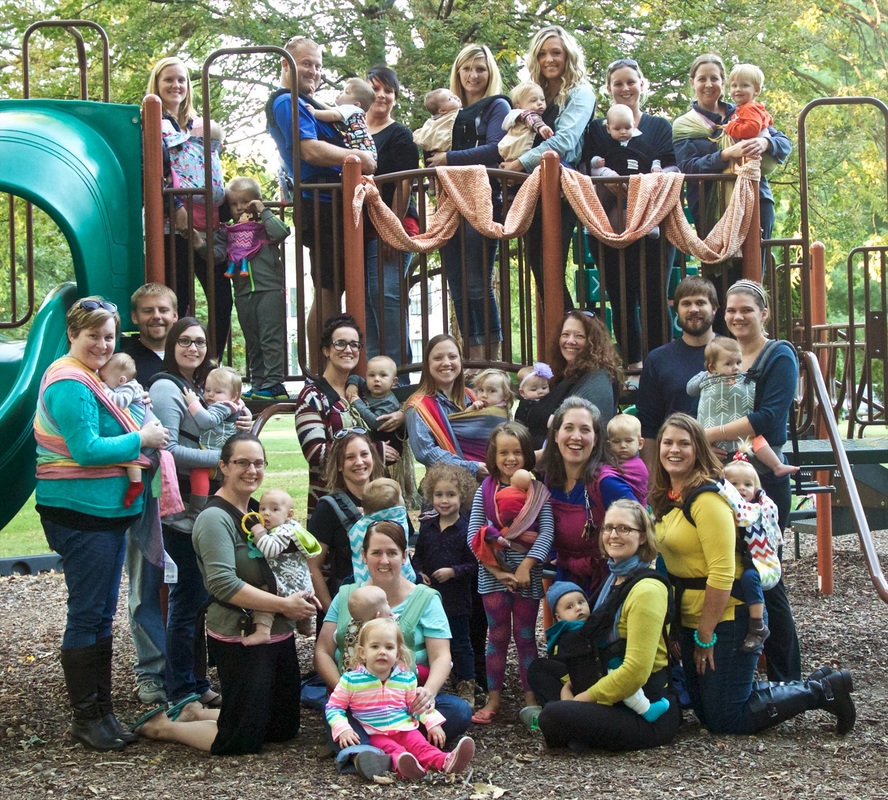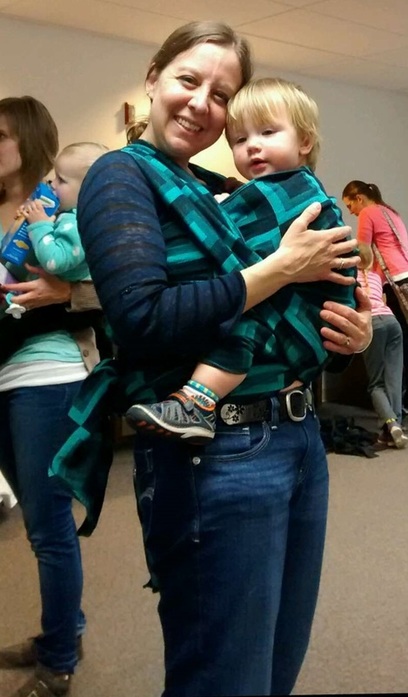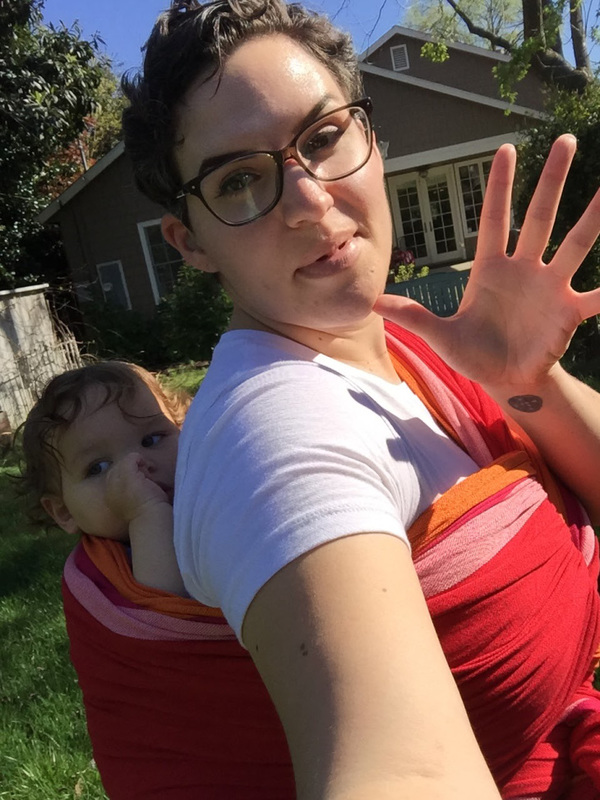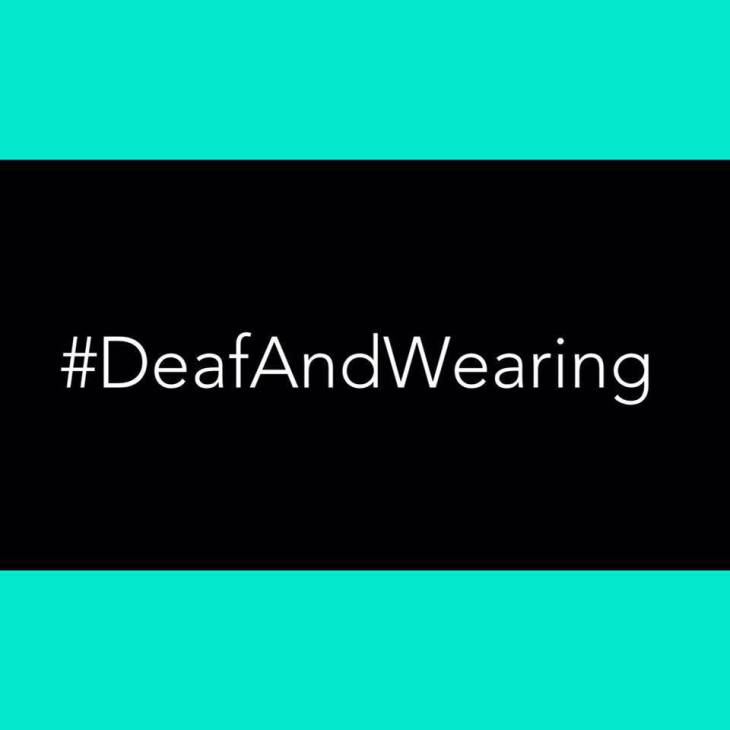|
If you have ever asked for information about babywearing on an internet group dedicated specifically to babywearing, you have probably heard the advice: "Go to a babywearing group meeting!" It is a really common response when people ask for help. In fact, I've given that advice here! A group meeting is a great (free!) resource where you can learn about ideal positioning and different types of carriers, try on carriers to see what you (and your baby) like, get help with troubleshooting, and learn new skills, like feeding in a carrier, back carries, and more. Plus, if you like meeting new people and want to meet other families with babies, groups can be a great place to do that! That sounds scary! If you're like me, maybe you are a bit cautious about going to new places and meeting new people. Maybe you have a really busy schedule or will have to make some significant sacrifices (time off work, gas money or finding a ride, especially to a meeting that may be very far away) to be able to attend this thing that everyone says is so great. Maybe you have a child who is stressed by busy, noisy places. Maybe you are struggling with your mental health as a new parent, and while you've heard babywearing might help you cope with postpartum depression, you have no idea where to start, and this group thing seems like too much. I like to make an informed decision about whether I'll go to something new, by learning about what to expect. Understanding what will happen is how I decide whether it will be worth my time, whether I'll feel overwhelmed or uncomfortable, and whether my children will be able to cope well with the environment. If you're like me and like to "know before you go," this post is for you! The "secret handshake" Just kidding. There's no secret handshake! But there is a secret code - the jargon and specific phrases that are often used at meetings can seem like a whole new (and very confusing!) language. Most of the time, people who are providing instruction or help will explain these terms when they use them, but sometimes you might need to ask for them to repeat or clarify. Don't be shy about this! In general, the people who volunteer at meetings are friendly and really want to share the babywearing love, and they are used to answering all kinds of questions. Groups are different! Babywearing groups are not all the same. There are groups that are affiliated with Babywearing International, and groups that are "independent" (or, unaffiliated). There are enormous groups (seriously, 100+ people at a meeting!) and tiny groups (just a few people getting together at someone's house). There are groups with lots of structure (introductions, lecture topics, instruction, try on and practice, carrier check out), and groups with minimal structure (just drop in sometime during the scheduled meeting time, and get the help you need). There are groups with many meetings all over town every month, and groups that meet in the same place, same time every month. There are groups with large lending libraries of carriers that can be checked out by meeting attendees, and there are groups that have a small demonstration library of carriers you can learn with or try on at a meeting but cannot take home. Some groups have a clear leadership structure where only leaders can provide instruction, and in other groups, all attendees may help each other with carriers. There are some groups that are affiliated with other special interest groups, like breastfeeding, attachment parenting, and more. But also they are kind of the same Things that almost all groups have in common: the main focus of a meeting is babywearing, and you are encouraged to bring your baby, if you have one! Most groups have a Facebook group or page, and some also have websites, blogs, Instagram, Twitter, and good old e-mail. Try to contact them via one of these formats, and ask questions before you go, to understand what type of group it is! What to expect For groups that have some type of structure, the following agenda is fairly typical:
The fine print Other than the meeting agenda, here's a few other details you should know:
Some thoughts on accessibility OK, time to get really serious here for a minute. While babywearing groups are a fantastic community service in many regards, it would be irresponsible of me to not provide some thoughts regarding inclusivity and accessibility. Groups tend to overwhelmingly have members who are white, straight, female, and have some financial privilege. If you are a person of color or gay, you should be prepared that you may be the only one there. If there are only a couple of meetings in a month, they tend to be during the day, making them inaccessible for families who work during the day. They tend to take place at locations in wealthier or suburban areas, making them inaccessible or at the very least intimidating for families in lower-income area or who do not have transportation. This is often because the meeting times and locations are determined by the people who have the time, energy, and privilege to be volunteer leaders. If they are stay-at-home parents, they tend to choose meeting times that work best for their families' schedules. Carriers that retail between $100-150 are frequently recommended when families who are new to wearing ask for recommendations, making babywearing seem inaccessible to families who are on a budget. (Spoiler alert: it's not.) While these problems are not universal (remember there are all types of groups, in all types of communities?), they are quite common and worth mentioning specifically. There are some groups who are actively working to make changes to increase accessibility and inclusivity, but overall most groups have a long way to go. Go! And give back! If you have the means and availability to attend a group meeting, it can be a great way to learn more about using carriers and a great place to meet other families. Once you've learned what it is that you came to learn, keep attending if you can, and contribute to an environment of support for other new wearers! ! If you are able, consider volunteering your time to help out at meetings. Many groups are in need of volunteers who can sustain and even expand this great community resource, and many will be happy to find a way for you to help! To see if there is a babywearing group near you, check these links: https://wrapsodybaby.com/babywearing-resources/find-a-babywearing-group-near-you/ https://wrapyourbaby.com/babywearing-groups/ http://paxbaby.com/groups/
2 Comments
One of the ways that babywearing instruction and information is obtained is through video tutorials about using carriers. For hearing caregivers, this usually works well. But for caregivers with hearing loss, this modality is lacking. Often, the instruction is verbal and there is no captioning of any type. While the visual information is helpful, crucial information is lost from the narration. Deaf or Hard-of-Hearing caregivers have had difficulty finding resources to learn carrying.
This post will highlight the resources available to Deaf and Hard-of-Hearing caregivers. Wrap in ASL - Elena Ruiz maintains a lovely blog with reviews and photos, a Facebook page and Instagram, and also a babywearing-focused YouTube channel with all videos in ASL. She is an active advocate for Deaf babywearers. Deaf Babywearing Community - this Facebook group is a group exclusively for Deaf, Hard-of-Hearing, DeafBlind, and DeafDisabled parents and caregivers to learn about babywearing. Deaf Babywearing Access - this Facebook group is a space where Deaf, DeafBlind, DeafDisabled, and Hard-of-Hearing babywearers and their hearing supporters can address access to babywearing information at meetups, conferences, consultations, and more. Amy Wraps Babies - All videos at this YouTube channel are fully captioned. Wrapping Rachel - All videos at this YouTube channel are fully captioned. Wrap You In Love - This educator maintains a comprehensive website (with reviews, photos, tutorials, and more) and a YouTube channel with captioned videos. For further search options, the Deaf babywearing community uses the hashtag #DeafAndWearing on social media. If you know of any more resources that you think should be included on this list, please leave a comment, or contact me and I will add them! |
AuthorBeth. The babywearing lady. Archives
May 2017
Categories
All
all content
copyright 2016 Beth Secrist All photos used under the Creative Commons license through Flickr. Photography by: littletuesday12 |




 RSS Feed
RSS Feed